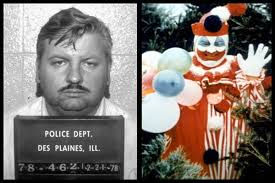Why do clowns scare some people?
- Steph Young
- Jan 16, 2018
- 4 min read
Coulrophobia, or fear of clowns... Lore or real....
Their garish exaggerated facial features can transform them into the monster in the closet and other such archetypal creatures from our darkest nightmares, or even our reality, such as visitations from ghost-clowns.
Clowns, jesters, tricksters, jokers and harlequins have appeared for centuries throughout many cultures: the court jesters of medieval England, Pygmy clowns of ancient Egypt, and Ancient Rome’s the ‘stupidus’ figure.

The Smithsonian quotes French literary critic Edmond de Goncourt, who wrote in 1876, “The clown’s art is now rather terrifying and full of anxiety and apprehension. Their suicidal feats, their monstrous gesticulations and frenzied mimicry reminding one of a lunatic asylum.”
The less manic clowns, the staple troubled, sad, and tragic clown variety in the form of the tattered “hobo” homeless clowns were no less troubling to watch.

There are some horrifying claims, though not easily substantiated, that in the Middle Ages, jesters were mutilated if they failed to make the court laugh; their faces cut into a permanent smile by the removal of their muscles that would make frowns.

As for the release of the 2017 Stephen King movie ‘IT,’ his clown is now depicted in classic Harlequin quality, with elegance of costume. ‘Pennywise’ has been described by theatre critics as ‘a harlequin-from-hell.’ Of course, in the fore-front of people’s psyche will always be John Wayne Gacy’s clown Pogo. Between 1972 and 1978 he sexually assaulted and killed more than 35 adolescent boys. When he went to entertain children and adolescents, dressed in his clown costume, what no-one knew was that he had already been convicted of sexually assaulting a teenage boy.

In contemporary times, Stephen King’s demon clown ‘Pennywise,’ Heath Ledger’s ‘The Joker’ in Batman and also ‘Punch and Judy’ as the henchmen of the Joker, DC Comics’ cloddish supervillains ‘Punch and Jewellee,’ and perhaps even the Insane Clown Posse’s grease-paint and their Dark Carnival performances, have all only solidified the fear of the unpredictable often frenzied persona of the murderous Clown or any other similar trickster characters, and this abiding fear lies in the soul of not just children but us adults too.

In the ‘Clown sightings’ outbreak of 2016 throughout America and England, online magazine Mashable synchronistically remarked; ‘Since the late summer, there have been about a half-dozen reports of clown sightings. Alleged sightings mapped along the border between the Carolinas, form a sort of ‘harlequin triangle’ between Greenville, Greensboro and Winston – Salem, North Carolina.’
The Washington post pointed out: ‘The incident seems to follow a script that has repeated itself several times over in the area since late August: Witnesses phone local police to report a menacing clown or clowns, but officers cannot verify the sightings.’
Fortean Loren Coleman first used the term “Phantom Clowns” after researching a “clown flap” in the early 1980’s, of children possibly being bundled into run-down and archaic vans.
Patrick Harpur in Daimonic Reality wrote of a strange and troubling variation: heavily made up “Phantom Social Workers.” In the early months of 1990 across England a similar pattern to the “Phantom Clowns” played out. Instead of clown costumes, they came wearing suits and heavy make-up on their faces. The police dealt with an ever-growing number of reports from concerned and distressed parents who had received unexpected visits from social workers who had turned up on their doorsteps, asking to come in to see their children. When the parents became suspicious, they would retreat and leave. Mostly these visitors were women, wearing very heavy make-up that would have been wholly inappropriate for a social worker.

They carried identification and clip boards. Sometimes they did phone in advance. “Operation Childcare” was set up by combined police forces to track down these bogus authority figures. Sometimes they were reported to operate in groups but strangely the police felt it was several different groups. Were they real paedophile groups, phantoms, or like the so-called Men In Black visits?
Fear of clowns and similar such disturbing characters is attributed by some to the “uncanny valley effect.” This is said to be the phenomenon where things that look human but aren’t quite, are as a result, deeply unsettling to the human psyche. Our reaction upon seeing such grotesque monsters is a dip in emotional response that occurs as we are confronted by such.
The term “uncanny valley” derives from robot maker Masahiro Mori, in 1970, who hypothesised that as robots grew more human in appearance and character, people would grow to accept them as more familiar when compared to earlier more mechanical and rudimentary models. However, the closer they became to human-like, the more disconcerted and uncomfortable people became and their responses of unease heightened.
Exaggerated postures and exaggerated facial features on human-like faces unsettle our subconscious, unnerve us with their unpredictability, and threaten us.
Perhaps the greatest fear from all of these archetypes is that their unnaturally fixed exaggerated and grotesquely frozen expressions make them so surreal, so nightmarish, and that these faces seem to hide their real nature… When the grease-paint is wiped off, what is left….?
Here is one man’s very disturbing account of a clown-like Harlequin figure that has stalked him all his life:




















